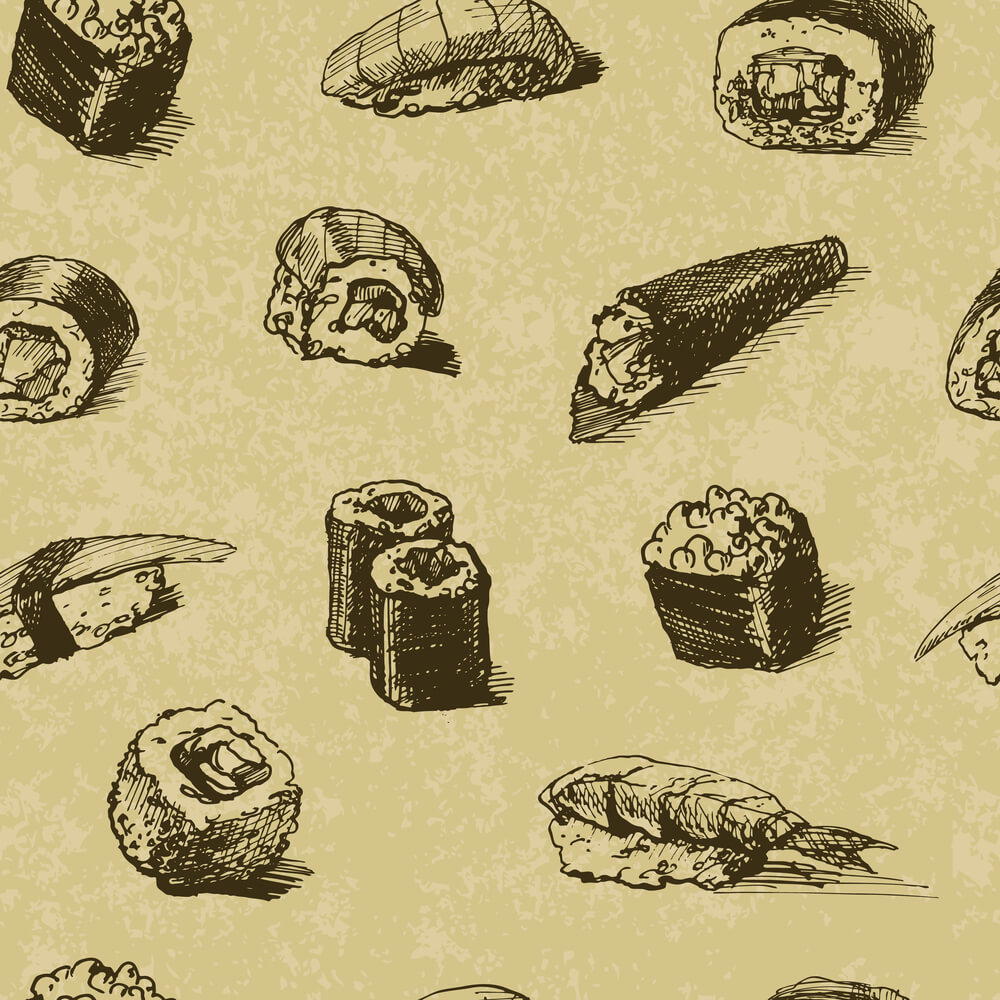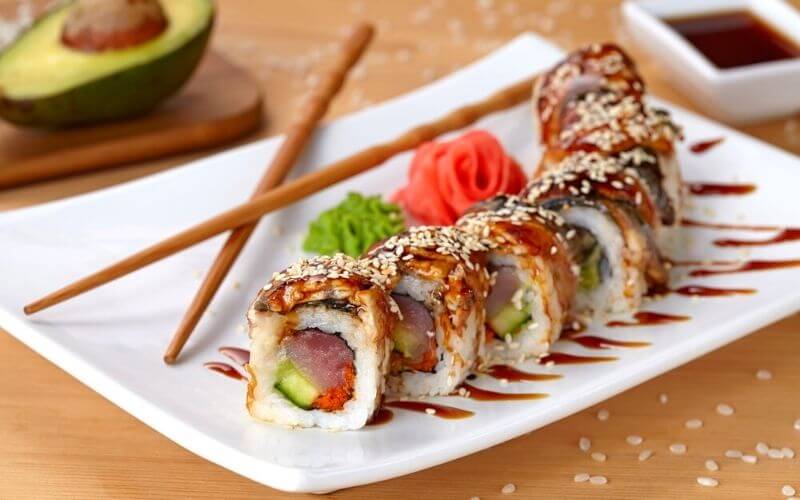If you happen to order sushi regularly, something that might have come to your mind is sushi roll vs hand roll. Even though they sound very much the same, they are not!
But what is a sushi roll and what exactly is a hand roll? If you want to know more about the difference between these two and the eBay way to eat sushi, keep on reading!
History of Sushi

Sushi is one of the oldest dishes that can be traced as far back as the 4th century!
The modern sushi that we all know and love looks and tastes nothing like the sushi from that time. Even though we simply assume sushi originated in Japan, China created the first-ever sushi dish.
In China, sushi was a way to keep fresh fish edible for longer. They used to place fresh fish on fermented rice to increase the shelf life. It tasted similar to pickled fish.
This method of preservation happened by accident! Farmers used to bury fish with rice for storage and realized this makes the fish last longer. And that’s how sushi was born!
Since then sushi has gone through an evolution in itself. The sushi that we know now is a product of the 20th century.
The modern sushi roll and hand rolls we are accustomed to eating are not traditional recipes either. That doesn’t mean they are not delicious!
With our fast-paced lifestyle, temaki and maki sushi is a great way to have a nutritious full meal on the go. No wonder it’s so popular in the west!
Rolled Sushi or Maki Sushi

Sushi roll is called “Maki” in Japanese which is short for Makizushi. It’s called Maki because it’s made using a makisu aka bamboo mat. Maki sushi is sushi that looks almost cylindrical and then cut into thin pieces.
Maki sushi is known to originate during the Edo period which was in the 18th century. So it’s a relatively new addition to the sushi family.
The reason why maki sushi became so popular is because of its easy and versatile ingredients. You can use any type of protein or vegetables to make it. This means maki sushi can be enjoyed all year round.
You can make maki sushi with either thin pieces of veggies or thicker pieces to make a bigger roll. Maki sushi contains sushi rice, nori sheets, and fresh fish and veggies.
The seaweed sheet is first laid on the bamboo mat and then a thin layer of seasoned sushi rice is spread on top of it. Then you can add your favorite fillings.
You can add thin cuts of fresh fish or veggies and then use the mat to wrap the sheet into a round roll. When it’s tightly rolled, cut them into smaller 1-inch pieces. Make sure your knife is super sharp or the roll will crumble and break.
Maki sushi is super easy to make at home. You don’t need a lot of skill or knowledge to make a sushi roll.
If you don’t know how to use a bamboo mat, some fun gadgets can do it for you! They might look sketchy but trust us, some of them are very fun to use. I like to use Camp Chef Sushezi as it makes perfectly rolled sushi each time. It’s a lot of fun to do this with kids and family together!
Types of Maki Sushi:
Maki sushi comes in a wide variety of styles so there’s a lot to discover. We are going to mention the most popular ones today!
Hosomaki:
Hosomaki is the smallest-sized sushi and is known for its thin appearance. Hosomaki means small. This type of sushi uses only one filling which is why it’s so thin.
Some of the popular types of hosomaki sushi include:
- Kanpyo maki
- Kappa maki
- Shinko maki
- Natto maki
- Tekka maki
Futomaki:
Futomaki means thick rolls. This is the polar opposite of hosomaki. You will find a lot of different fillings in futomaki like shrimps, cucumber, crab, eel, tofu, eggs, and a range of vegetables.
The most popular type of futomaki is called ehomaki which is kade using seven different ingredients to represent seven gods of fortune in Japanese culture. This dish is eaten during a festival called Setsubun.
Nakamaki:
The third type of maki sushi is called nakamaki which is an in-between size. It’s not too thick like futomaki and neither too thick like hosomaki. You will find on average three ingredients so it’s very convenient to eat.
Read More: What is Tobiko in Sushi? and What is Masago in Sushi?
Hand Roll/ Temaki Sushi

Hand roll or temaki sushi is casual-style sushi that’s very popular in Japan. It looks cone-like and is wrapped in nori sheets.
You won’t find temaki sushi in formal Japanese restaurants as it’s a very homey dish. While we know sushi for its artistic and skilled style, temaki is the opposite of that. You don’t need any particular skills to make a delicious temaki at home.
Temaki is a very good choice for parties and hangouts as it takes only a few minutes to make. All you have to do is wrap a scoop of seasoned rice in a nori sheet and add your favorite fish and fillings on top. The fillings are called neta in Japan.
You can eat temaki with any type of sauce. We love to mix our fish slices in garlic mayo with a few drops of lemon juice. It’s divine!
Temaki is traditionally eaten with bare hands as it’s more convenient. One thing you are never supposed to do with temaki is letting it sit for hours before eating.
You should enjoy temaki sushi immediately after it’s made. That’s because the nori sheet can turn soggy if it sits for too long.
If you want to make classic temaki at home, here are some fillings ideas to try:
- Add radish sprouts with cucumber slices.
- Baked salmon tastes good with fresh vegetables.
- Avocado slices with scallions and salmon with sesame seeds.
- Spicy tuna and radish sprouts.
- Crab and Kewpie Japanese Mayonnaise with roasted nori sprinkles.
What is the Difference between Roll and Hand Roll
I think it’s pretty clear by now how different hand rolls and sushi rolls are. Let’s look at some of the key features of maki sushi and temaki sushi.
Sushi Roll:
- Sushi roll or Makizushi means something that’s wrapped or coiled.
- Sushi rolls contain cooked fish, rice, crab, shrimp, and vegetables.
- Maki sushi rolls rarely have raw fish.
- The maki rolls are made using a bamboo mat to give the cylindrical shape.
- Maki rolls are cut into relatively smaller pieces so that they can be eaten with chopsticks.
- Sushi rolls are cut and served in a dish so they can be shared.
- Sushi rolls are always wrapped in nori sheets or soy sheets.
- Sushi rolls require skill and precision to make them perfectly.
- Maki sushi is often found in formal restaurants as it’s a classic dish.
- Some of the popular ingredients in maki sushi include mushrooms, omelets, cucumbers, and sakura denbu.
Hand Roll or Temaki:
- The name Temaki refers to something with a conical shape.
- Hand rolls are much larger than sushi rolls. They are not bite-size pieces. Instead, you get something that resembles a mini burrito.
- Hand rolls are made using only hands as tools. You don’t need a bamboo mat for this.
- Temaki is usually made with raw fish instead of cooked ones.
- A hand roll is not meant to be shared as it’s made for one person only.
- Unlike sushi rolls, hand rolls do not require rice to make. Some of them contain only veggies and fish.
- You don’t need chopsticks to eat hand rolls. It is eaten with bare hands.
- Temaki is a casual food that’s very popular for home parties.
- When hand rolls are made at home, it’s made with cooked ingredients like smoked salmon, fried seafood, etc.
Do Hand Rolls Have Sushi Rice?
Hand rolls or temaki contain rice but it’s not always the case. Rice is the main ingredient in classic sushi rolls. Check out the Best Sushi Rice Brands in 2021.
With hand rolls, some contain a generous scoop of rice while others have very little. Some hand rolls have no rice at all. Your hand roll can have only fish and vegetables too.
Frequently Asked Questions
What Does Hand Roll Mean?
Hand roll or temaki is a taco or a burrito made using seaweed sheets, rice, and fish. The seasoned rice is put on the nori sheet and then wrapped into a cone-like shape.
On top of the rice, fish, veggies, and other toppings are added. It’s a simple and easy food to make and enjoy.
What is a Classic Roll Sushi?
Classic roll sushi is a type of sushi that’s made using a bamboo mat. A seaweed sheet is laid on top of the mat and then a small layer of rice is added. You can add any fillings you want. We love adding seafood to our classic roll.
Then the mat is wrapped to create a cylindrical shape which is then cut into bite-size pieces. Classic sushi rolls are very popular and are enjoyed with soy sauce, wasabi paste, and grated ginger.
How Do You Eat Sushi Hand Rolls?
Sushi hand rolls are eaten with bare hands. You don’t need any chopsticks or a fork for it. All you have to do is grab the sushi roll like a burrito and proceed to eat! It’s super convenient especially when you are on the go.
Do You Eat the Seaweed in a Hand Roll?
Of course! Seaweed is delicious when you combine it with rice. It has crispiness that’s very enjoyable to eat. The saltiness of the seaweed balances out the sweetness of mayo and rice.
Are California Sushi Rolls Cooked?
Yes, California sushi rolls use cooked fish and seafood instead of the classic Japanese style. Japanese sushi rolls have raw fish marinated in either mayonnaise or vinegar.
California sushi rolls are a fusion between eastern and western cuisine. It’s not authentic but absolutely delicious!
How Many Pieces in a Sushi Roll?
A standard sushi roll has 6-7 pieces of sushi. The number can vary depending on how long the sushi roll is and how chunky you want your sushi pieces to be.
Is Eating Sushi with Your Hands Rude?
If you are in Japan or a Japanese restaurant, it’s respectful to eat sushi with chopsticks. Japanese people respect their food and culture a lot. So eating sushi with your hands can be perceived as rude.
Takeaway
As the sushi trend is growing every single day, people are inventing fusion versions of maki and temaki.
It’s fun to see so many different varieties of sushi being celebrated with such passion. Whether you want a delicately made sushi roll or a quick-grab hand roll, the options are endless.
We do love our homemade version a lot though. Nothing can beat a freshly made temaki with some wasabi and ginger.
How do you like your sushi? What’s your favorite? Let us know in the comments below.
If you are looking for a way to store your maki rolls, check out our article Can You Freeze Sushi.






